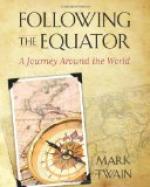In the region of Scandal Point—felicitous name—where there are handy rocks to sit on and a noble view of the sea on the one hand, and on the other the passing and reprising whirl and tumult of gay carriages, are great groups of comfortably-off Parsee women—perfect flower-beds of brilliant color, a fascinating spectacle. Tramp, tramp, tramping along the road, in singles, couples, groups, and gangs, you have the working-man and the working-woman—but not clothed like ours. Usually the man is a nobly-built great athlete, with not a rag on but his loin-handkerchief; his color a deep dark brown, his skin satin, his rounded muscles knobbing it as if it had eggs under it. Usually the woman is a slender and shapely creature, as erect as a lightning-rod, and she has but one thing on—a bright-colored piece of stuff which is wound about her head and her body down nearly half-way to her knees, and which clings like her own skin. Her legs and feet are bare, and so are her arms, except for her fanciful bunches of loose silver rings on her ankles and on her arms. She has jewelry bunched on the side of her nose also, and showy clusterings on her toes. When she undresses for bed she takes off her jewelry, I suppose. If she took off anything more she would catch cold. As a rule she has a large shiney brass water jar of graceful shape on her head, and one of her naked arms curves up and the hand holds it there. She is so straight, so erect, and she steps with such style, and such easy grace and dignity; and her curved arm and her brazen jar are such a help to the picture indeed, our working-women cannot begin with her as a road-decoration.
It is all color, bewitching color, enchanting color—everywhere all around—all the way around the curving great opaline bay clear to Government House, where the turbaned big native ‘chuprassies’ stand grouped in state at the door in their robes of fiery red, and do most properly and stunningly finish up the splendid show and make it theatrically complete. I wish I were a ‘chuprassy’.




